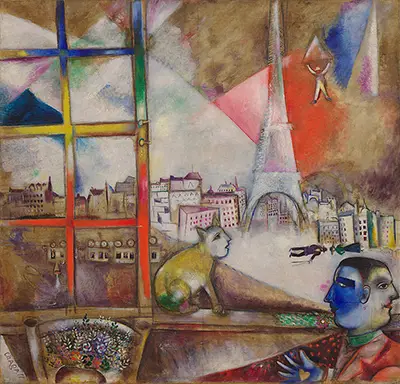The influence of the various Avant-Garde movements during this time can be clearly seen in this eccentric and excitable piece. On the very surface, it's a snapshot of daily life in Paris but evocative of the classic colour palette and whimsical modernity of the Cubist movement. The picture is painted in oil on a canvas measuring 136 x 141.9 cm. Semi-transparent planes of really vivid colour stretch above the famous Parisian skyline, with the iconic Eiffel Tower taking centre stage in the painting's landscape. Interestingly, there is a parachutist to the right of the tower, and this can be interpreted as a coming together of the old and traditional with the new human innovations of the time, an ode to a more contemporary Parisian experience. The very first successful jump from the Eiffel Tower was performed only two years prior to the painting’s creation in 1911, by a Russian inventor and adventurer no less.
Along with this more literal interpretation of the painting's contents is a more metaphorical reading, one that speaks of Chagall's leap of faith into the Western world and a new Western lifestyle. One of the many artists moving from the Eastern culture of Russia to the Western culture of mainland Europe at this time. In fact, Paris Through the Window is actually an enlarged and enhanced version of a window in a self-portrait that Chagall had painted in 1912, in which he contrasted Paris with his birthplace. This notion of pitting one’s birth town against one’s current town can also be recognised in the inclusion of the Janus, a Roman god with two faces that is shown as looking east towards Russia, and west towards France.
Chagall's nostalgia for his homeland is also represented by the upside-down train on the left-hand side of the painting. As a Jewish artist in the early 20th century, the unworkable nature of an upside-down train carriage signifies Chagall's inability to return to his home even if he desired to do so. Note also the humanlike face of the cat in the centre of the piece, not a testament to Chagall's inability to draw feline features, but rather a nod to the Jewish belief that sinners who have died often return as cats to haunt their family members.
